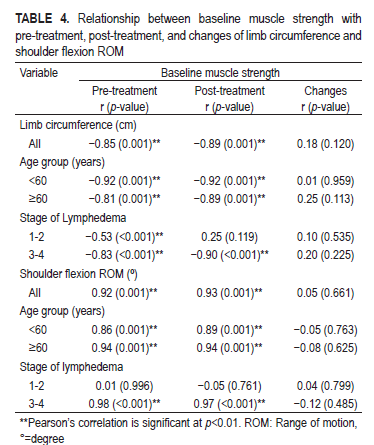Effectiveness of physiotherapy lymphedema management in limb circumference and shoulder mobility among women with breast cancer-related lymphedema
DOI:
https://doi.org/10.17532/jhs.2024.2238Keywords:
Breast cancer, Lymphedema, Physiotherapy, MalaysiaAbstract
Introduction: This study aimed to evaluate the effectiveness of physiotherapy lymphedema management (LM) in upper limb circumference (LC) and shoulder mobility and determine whether baseline muscle strength (MS) was associated with LC and shoulder mobility in women with breast cancer-related lymphedema.
Methods: This study analyzed 79 patients (mean age = 58.89 ± 10.22 years) who were categorized by age group (<60 and ≥60 years) and lymphedema stage (stages 1-2 and 3-4) and completed 8 sessions of LM. Key outcomes evaluated included shoulder flexor strength, LC, and shoulder flexion range of motion (ROM). Data were analyzed using a paired t-test and Pearson’s correlation based on age group and stage of lymphedema.
Results: There was a significant reduction in LC by 12.56%, 16.41%, 9.60%, 22.84%, and 7.76% for all patients, those aged <60 years (n = 38), ≥60 years (n = 41), stage 1-2 (n = 41), and stage 3-4 (n = 38), respectively (all p < 0.05). Shoulder flexion ROM improved by 3.99% (p < 0.05), 3.06% (p > 0.05), 5.06% (p < 0.05), 2.95% (p > 0.05), and 5.5% (p < 0.05) for all patients, those <60 years, ≥60 years, stage 1-2, and stage 3-4, respectively. Baseline MS was significantly correlated with LC at pre- and post-treatment for all groups (r = −0.53-−0.92) (p < 0.05), except for the LC of those with stages 1-2 of lymphedema at post-treatment while baseline MS was significantly correlated with shoulder flexion ROM at pre- and post-treatment in all groups (r = 0.86-0.98), except for stages 1-2.
Conclusion: An 8 sessions of LM may effectively reduce lymphedema and improve shoulder mobility. MS may be associated with LC and ROM; thus, the LM protocol should include regular assessment of MS and incorporate progressive strengthening exercises at an early stage.
Downloads

Downloads
Published
Issue
Section
Categories
License
Copyright (c) 2024 Arina Zaini, Maria Justine, Aiman Nadia Akmar Rahman

This work is licensed under a Creative Commons Attribution 4.0 International License.










